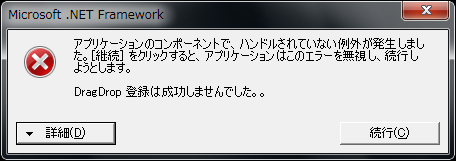2017/02/27追記
Windows環境以外でも動作するPowerCLI Coreが登場し、この手順を行おうとしたら、モジュール名が異なり実施できませんでした。
「PowerCLIとPowerCLI Coreの双方で動くPowerShellスクリプトの作り方」に、対処方法を記載しています。
1年前に「vSphere PowerCLIの一部コマンドがPowerShell ISEで動作しない」というのを書いた。
最近、環境を作り直すのと一緒にPowerShellを最新にして、そして、PowerCLIを最新の6.5にしてみた。(New Release: PowerCLI 6.5 R1)
以前と同じように、PowerShell ISE上で「Add-PSSnapin VMware.VimAutomation.Core」を実行すると、「Add-PSSnapin : No snap-ins have been registered for Windows PowerShell version 5.」というエラーが発生。
「Add-PSSnapin」は使わないようだ。
C:\Users\test3> Add-PSSnapin VMware.VimAutomation.Core
Add-PSSnapin : No snap-ins have been registered for Windows PowerShell version 5.
At line:1 char:1
+ Add-PSSnapin VMware.VimAutomation.Core
+ ~~~~~~~~~~~~~~~~~~~~~~~~~~~~~~~~~~~~~~
+ CategoryInfo : InvalidArgument: (VMware.VimAutomation.Core:String) [Add-PSSnapin], PSArgumentException
+ FullyQualifiedErrorId : AddPSSnapInRead,Microsoft.PowerShell.Commands.AddPSSnapinCommand
C:\Users\test3>
代替はなんだろ?と確認すると「Import-Module -Name VMware.VimAutomation.Core」。
いままでスクリプトにAdd-PSSnapin~と書いていたところを、どちらでも対応できるように書き換えるとすると、下記のようになるだろうか?
if ( $PSVersionTable.PSVersion.Major -lt 5){
Add-PSSnapin VMware.VimAutomation.Core
}else{
Import-Module -Name VMware.VimAutomation.Core
}
下記は参考資料の実行ログ
PS C:\Users\test3> Get-Module
ModuleType Version Name ExportedCommands
---------- ------- ---- ----------------
Script 1.0.0.0 ISE {Get-IseSnippet, Import-IseSnippet, New-IseSnippet}
Manifest 3.1.0.0 Microsoft.PowerShell.Management {Add-Computer, Add-Content, Checkpoint-Computer, Clear-Content...}
Manifest 3.1.0.0 Microsoft.PowerShell.Utility {Add-Member, Add-Type, Clear-Variable, Compare-Object...}
PS C:\Users\test3> Get-Module -ListAvailable
Directory: C:\Program Files\WindowsPowerShell\Modules
ModuleType Version Name ExportedCommands
---------- ------- ---- ----------------
Binary 1.0.0.1 PackageManagement {Find-Package, Get-Package, Get-PackageProvider, Get-PackageSource...}
Script 1.0.0.1 PowerShellGet {Install-Module, Find-Module, Save-Module, Update-Module...}
Directory: C:\Windows\system32\WindowsPowerShell\v1.0\Modules
ModuleType Version Name ExportedCommands
---------- ------- ---- ----------------
Manifest 1.0.0.0 AppLocker {Set-AppLockerPolicy, Get-AppLockerPolicy, Test-AppLockerPolicy, Get-AppLockerFileInform...
Manifest 1.0.0.0 BitsTransfer {Add-BitsFile, Remove-BitsTransfer, Complete-BitsTransfer, Get-BitsTransfer...}
Manifest 1.0.0.0 CimCmdlets {Get-CimAssociatedInstance, Get-CimClass, Get-CimInstance, Get-CimSession...}
Script 1.0.0.0 ISE {New-IseSnippet, Import-IseSnippet, Get-IseSnippet}
Manifest 1.0.0.0 Microsoft.PowerShell.Archive {Compress-Archive, Expand-Archive}
Manifest 3.0.0.0 Microsoft.PowerShell.Diagnostics {Get-WinEvent, Get-Counter, Import-Counter, Export-Counter...}
Manifest 3.0.0.0 Microsoft.PowerShell.Host {Start-Transcript, Stop-Transcript}
Manifest 3.1.0.0 Microsoft.PowerShell.Management {Add-Content, Clear-Content, Clear-ItemProperty, Join-Path...}
Script 1.0 Microsoft.PowerShell.ODataUtils Export-ODataEndpointProxy
Manifest 3.0.0.0 Microsoft.PowerShell.Security {Get-Acl, Set-Acl, Get-PfxCertificate, Get-Credential...}
Manifest 3.1.0.0 Microsoft.PowerShell.Utility {Format-List, Format-Custom, Format-Table, Format-Wide...}
Manifest 3.0.0.0 Microsoft.WSMan.Management {Disable-WSManCredSSP, Enable-WSManCredSSP, Get-WSManCredSSP, Set-WSManQuickConfig...}
Manifest 1.0.0.0 NetworkSwitchManager {Disable-NetworkSwitchEthernetPort, Enable-NetworkSwitchEthernetPort, Get-NetworkSwitchE...
Manifest 1.1 PSDesiredStateConfiguration {Set-DscLocalConfigurationManager, Start-DscConfiguration, Test-DscConfiguration, Publis...
Script 1.0.0.0 PSDiagnostics {Disable-PSTrace, Disable-PSWSManCombinedTrace, Disable-WSManTrace, Enable-PSTrace...}
Binary 1.1.0.0 PSScheduledJob {New-JobTrigger, Add-JobTrigger, Remove-JobTrigger, Get-JobTrigger...}
Manifest 2.0.0.0 PSWorkflow {New-PSWorkflowExecutionOption, New-PSWorkflowSession, nwsn}
Manifest 1.0.0.0 PSWorkflowUtility Invoke-AsWorkflow
Manifest 1.0.0.0 TroubleshootingPack {Get-TroubleshootingPack, Invoke-TroubleshootingPack}
Directory: C:\Program Files (x86)\VMware\Infrastructure\PowerCLI\Modules
ModuleType Version Name ExportedCommands
---------- ------- ---- ----------------
Binary 6.0.0.0 VMware.DeployAutomation
Binary 6.0.0.0 VMware.ImageBuilder
Binary 6.5.0.4... VMware.VimAutomation.Cis.Core
Binary 6.5.0.4... VMware.VimAutomation.Cloud
Manifest 6.5.0.4... VMware.VimAutomation.Common
Binary 6.5.0.2... VMware.VimAutomation.Core HookGetViewAutoCompleter
Binary 6.0.0.0 VMware.VimAutomation.HA
Binary 7.0.2.4... VMware.VimAutomation.HorizonView
Binary 6.5.0.4... VMware.VimAutomation.License
Binary 6.5.0.4... VMware.VimAutomation.PCloud
Manifest 6.5.0.4... VMware.VimAutomation.Sdk Get-PSVersion
Binary 6.5.0.4... VMware.VimAutomation.Storage
Binary 6.5.0.4... VMware.VimAutomation.Vds
Binary 6.5.0.4... VMware.VimAutomation.vROps
Binary 6.0.0.0 VMware.VumAutomation
PS C:\Users\test3> Import-Module -Name VMware.VimAutomation.Core
C:\Users\test3> Get-Module
ModuleType Version Name ExportedCommands
---------- ------- ---- ----------------
Script 0.0 Initialize-VMware_VimAutomation_Cis
Script 1.0.0.0 ISE {Get-IseSnippet, Import-IseSnippet, New-IseSnippet}
Manifest 3.1.0.0 Microsoft.PowerShell.Management {Add-Computer, Add-Content, Checkpoint-Computer, Clear-Content...}
Manifest 3.1.0.0 Microsoft.PowerShell.Utility {Add-Member, Add-Type, Clear-Variable, Compare-Object...}
Binary 6.5.0.4... VMware.VimAutomation.Cis.Core {Connect-CisServer, Disconnect-CisServer, Get-CisService}
Manifest 6.5.0.4... VMware.VimAutomation.Common
Binary 6.5.0.2... VMware.VimAutomation.Core {Add-PassthroughDevice, Add-VirtualSwitchPhysicalNetworkAdapter, Add-VMHost, Add-VMHostN...
Manifest 6.5.0.4... VMware.VimAutomation.Sdk Get-PSVersion
C:\Users\test3>
なお、PowerCLI 6.5を起動した場合に読み込まれているモジュール一覧は以下の通り
Welcome to VMware PowerCLI!
Log in to a vCenter Server or ESX host: Connect-VIServer
To find out what commands are available, type: Get-VICommand
To show searchable help for all PowerCLI commands: Get-PowerCLIHelp
Once you've connected, display all virtual machines: Get-VM
If you need more help, visit the PowerCLI community: Get-PowerCLICommunity
Copyright (C) VMware, Inc. All rights reserved.
PowerCLI C:\> Get-Module
ModuleType Version Name ExportedCommands
---------- ------- ---- ----------------
Script 0.0 Initialize-VMware.VimAutomation....
Script 0.0 Initialize-VMware.VimAutomation....
Script 0.0 Initialize-VMware.VimAutomation....
Script 0.0 Initialize-VMware_DeployAutomation
Script 0.0 Initialize-VMware_VimAutomation_Cis
Script 0.0 Initialize-VMware_VumAutomation
Manifest 3.1.0.0 Microsoft.PowerShell.Management {Add-Computer, Add...
Manifest 3.1.0.0 Microsoft.PowerShell.Utility {Add-Member, Add-T...
Binary 6.0.0.0 VMware.DeployAutomation {Add-DeployRule, A...
Binary 6.0.0.0 VMware.ImageBuilder {Add-EsxSoftwareDe...
Binary 6.5.0.4... VMware.VimAutomation.Cis.Core {Connect-CisServer...
Binary 6.5.0.4... VMware.VimAutomation.Cloud {Add-CIDatastore, ...
Manifest 6.5.0.4... VMware.VimAutomation.Common
Binary 6.5.0.2... VMware.VimAutomation.Core {Add-PassthroughDe...
Binary 6.0.0.0 VMware.VimAutomation.HA Get-DrmInfo
Binary 7.0.2.4... VMware.VimAutomation.HorizonView {Connect-HVServer,...
Binary 6.5.0.4... VMware.VimAutomation.License Get-LicenseDataMan...
Binary 6.5.0.4... VMware.VimAutomation.PCloud {Connect-PIServer,...
Manifest 6.5.0.4... VMware.VimAutomation.Sdk Get-PSVersion
Binary 6.5.0.4... VMware.VimAutomation.Storage {Copy-VDisk, Expor...
Binary 6.5.0.4... VMware.VimAutomation.Vds {Add-VDSwitchPhysi...
Binary 6.5.0.4... VMware.VimAutomation.vROps {Connect-OMServer,...
Binary 6.0.0.0 VMware.VumAutomation {Add-EntityBaselin...
PowerCLI C:\>
